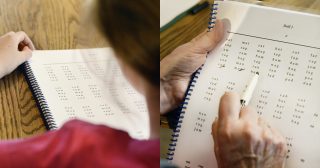20 Activities: Improve Visual Processing in LD & Dyslexic Children
February 19th, 2009R. B. just asked, “Could you suggest some activities for improving visual processing in L.D or dyslexic children?”
There are 9 areas of Visual Processing that affect learning. So, what I’m going to do is to present a few activities for three of those areas in this post and then post additional activities in future posts.
Visual Motor: The ability to relate visual stimuli to motor responses in an appropriate way.
- Swing arms in coordinated manner while walking, running, or jumping.
- Hopping activities, play hop-scotch.
- Jump rope, leap frog, skipping.
- Play Simon Says
- Balance beam activities.
- Tight rope activities – use masking tape on the floor, pretend it is a tight rope and skip, hop, or jump on the line.
- Coloring activities.
- Tracing activities.
- Copy words, sentences, or paragraphs from the chalkboard or desk.
- Complete dot-to-dot pictures
Visual Figure Ground: The ability to visually attend to the designated stimulus and not be distracted by the background.
- Have your student/s find hidden objects in pictures, including geometric shapes.
- Block out areas of the page so students don’t have too much coming at them – limiting thee background material.
- Provide books that have hidden pictures in them and look for the hidden pictures.
- Have your students find specific items in an aquarium.
Visual Discrimination and Form Constancy: The ability to discern similarities and differences visually.
1. Do sorting activities (use nuts, bolts, buttons, seeds, shells, blocks, etc.). After sorting, have students verbally describe the differences and similarities between objects.
2. Use colored blocks, make a pattern with them, and have the student copy the pattern.
3. Sorting activities where students put different objects into respective containers.
4. Sort shapes or letters – magnetic ones or pictures of them.
5. Put a letter on the board or piece of paper and have students circle all of the letters that are the same from a page in a book, magazine, or newspaper.
6. Match letters or words on a page.
Definitions of the areas are excerpted from the Learning Difficulty/Disability Pre-Screening and Informal Comprehensive Identification Tool. It will be available soon. The book contains more information on the impact difficulties in these areas have in the classroom as well as how to determine if your student has difficulties in any of these areas.


































